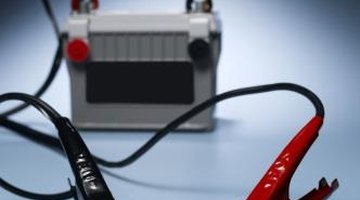How to Wire an Inverter to a Battery & Circuit Breaker
If you are building your own alternative energy system at your home, then at some point you will need to connect your power supply to an AC inverter, battery and circuit breaker so that you can utilize the electricity produced. Some of the steps and requirements for this activity involve a delicate process that could cause damages to your electrical system. If at any point you feel that you are in over your head, consult a licensed electrician so that the work is done properly and safely.

-
Calculate the total amp rating of the appliances that you want to run from solar. Writing this list down with pen and paper will help to organize your thoughts. This will help to determine how many batteries you will need as well as the circuit configuration of the wiring that connects the batteries. Use a calculator to multiply each appliance's amperage requirement by how many hours you normally run your appliances each day. The sum of each total for each appliance should be about 50% of the total discharge of your battery bank. For example, if your appliances generally run 100 amp hours, you will want a battery bank that will hold up to 200 amp hours of charge.
-
Use electrical wiring to connect your alternative energy production means, whether it is a wind-mill, solar panels or another type of system, to a charge controller. The charge controller will prevent the batteries from becoming overloaded so that their lifespan is increased.
-
Run electrical wire from the charge controller to your battery bank. Depending on the amp rating and voltage of your batteries, you will need to choose between wiring the batteries together in a series, parallel or a series-parallel circuit. Each type of circuit has its own advantages and disadvantages. A series circuit doubles the voltage, whereas a parallel circuit will double the amperage. Use electrical wire to connect the batteries into a circuit system by connecting the positive and negative terminals of adjacent batteries until all batteries are connected together. A parallel circuit is wired by connecting the positive terminals of each adjacent battery and the negative terminals of each adjacent battery. Doing both configurations will give you a series-parallel circuit, which will double the voltage and the amperage of the batteries.
-
Plug the positive wire leading from the circuit to the inverter. Plug the negative wire leading from the circuit to the inverter as well. The inverter will change the electricity from direct current (DC) to alternating current (AC), which is the form that a majority of home appliances utilize.
-
Run electrical wiring from your inverter to your circuit breaker panel. You cannot install any wiring to your box while electricity is still running to your home. Wrap any exposed wiring around or near your circuit breaker box, including the wiring coming from your inverter in order to protect it from becoming damaged.
-
Open the front cover of the breaker box with a screwdriver and turn the main circuit breaker switch off so that electricity is not running through the circuit breaker box. Most homes will have the main circuit breaker located on or near circuit breaker box.
-
Use a flat-head screwdriver to unscrew the front panel on your circuit breaker box. This system will work best if you can install a new electrical outlet and use an unused circuit breaker. Otherwise, you will need to disconnect the electrical wires for a specific circuit breaker and outlet so that you can utilize your alternative energy system for those specific appliances.
-
Connect the wiring from the inverter to the back of the circuit breaker according to the setup that you have decided upon for using that electricity in your home. If it involves putting in a new outlet just for the alternative energy system, then you can choose exactly where you want that outlet to be placed.
-
Test your system with an ammeter, which measures the current coming from your inverter.
-
Reconnect the front panel of your circuit breaker box and turn the main switch back on so that electricity is flowing to your home.
References
Resources
Tips
- Working with electricity is dangerous and risky; 110 volts of current has the potential to be lethal.
Writer Bio
David McGuffin is a writer from Asheville, N.C. and began writing professionally in 2009. He has Bachelor of Arts degrees from the University of North Carolina, Asheville and Montreat College in history and music, and a Bachelor of Science in outdoor education. McGuffin is recognized as an Undergraduate Research Scholar for publishing original research on postmodern music theory and analysis.
Photo Credits
- Jeffrey Coolidge/Photodisc/Getty Images
More Articles



